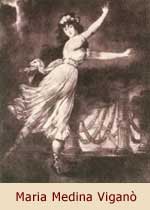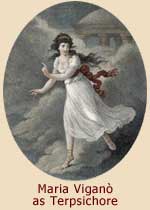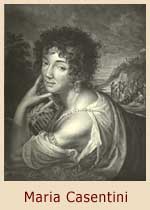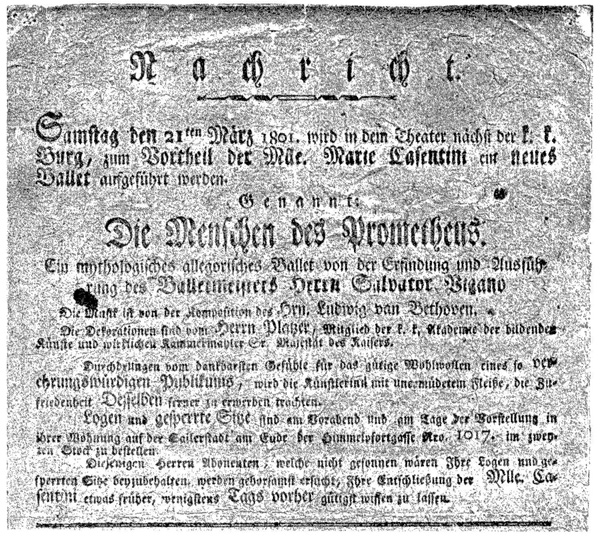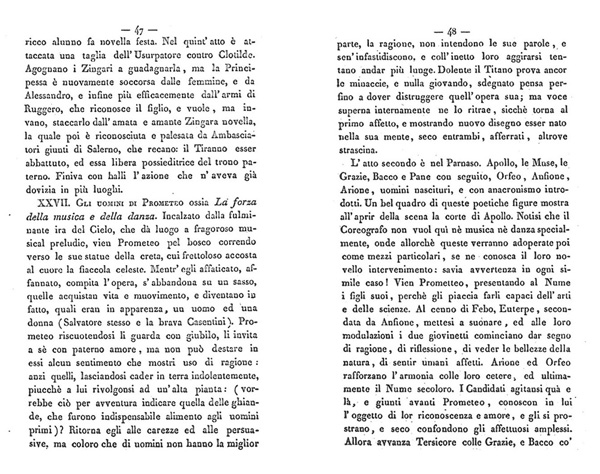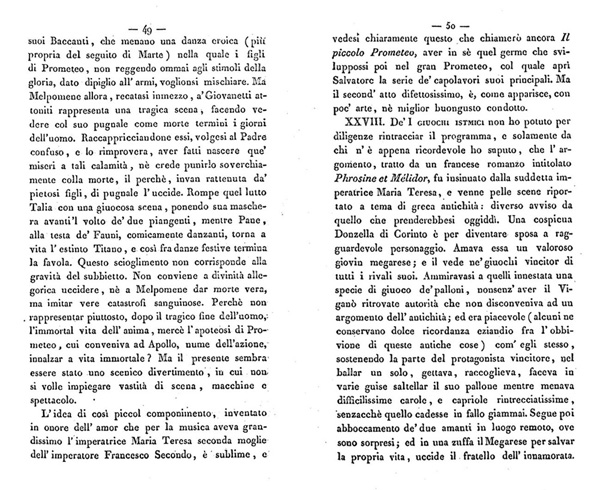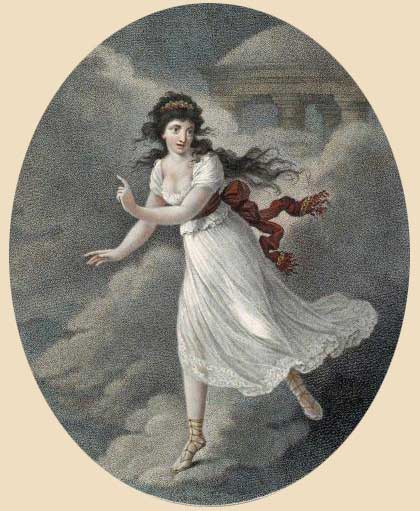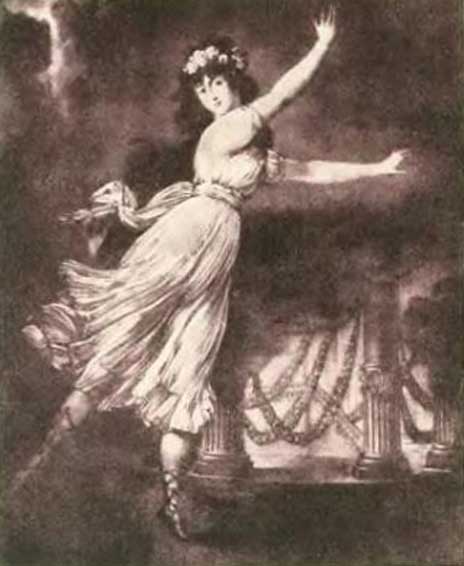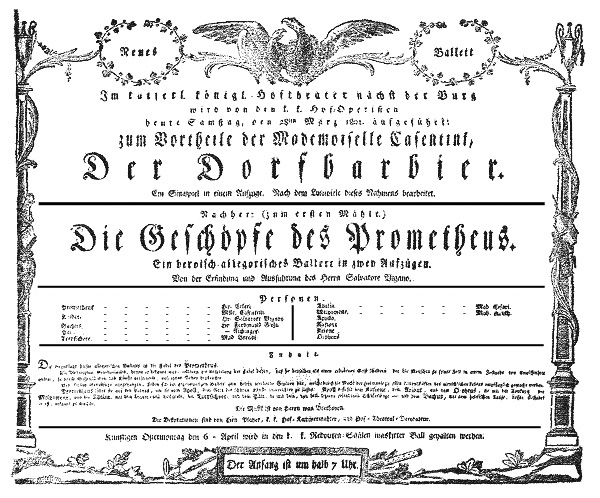In January 1801 Beethoven gave priority in his regimen to a new commission to write the music for a ballet to be presented at the Imperial Theater. We do not have the details of the commission, or of how the choice fell upon Beethoven to write the music. We do know, however, that the Empress herself, Marie Therese, had something to do with the matter, for that is how Beethoven himself reported it.22 To understand her involvement, and its consequences for this ballet in particular, we have to review the background of the ballet master, one Salvatore Viganò.
Viganò was born in Naples 21 months before Beethoven, in March 1769.23 His father was a noted choreographer and dancer; his mother was the sister of the composer Luigi Boccherini. Viganò grew up dancing, playing the violin and learning the art of composition (evidently, however, without the help of his famous uncle, who by then resided permanently in Spain).24 His debut as a ballet dancer came in 1783 when he was just fourteen; from then until 1788 he danced the female roles in his father’s ballet company, since at that time women were not allowed on stage in Rome or Naples. At the age of nineteen he went to Madrid, where he took part in the coronation festivities for Charles IV and there met Jean Dauberval, an encounter which was to define his career. Dauberval was a well-respected French choreographer, and a follower of the principles of the “ballet d’action” as developed by the 18th-century ballet master Jean-Georges Noverre (for whose ballet Les petits riens no less than Mozart had written the music).25 In Spain, too, Viganò met and married Josepha Maria Medina, a beautiful and highly talented ballet dancer who had made a successful transition from her native Vienna to Spain.26 Dauberval took them with him to London, but the climate there was not conducive to their blood, and they returned to the Continent.
Back in Italy, and working with his new wife in Venice (which did allow females to dance on stage), Viganò staged Dauberval’s most celebrated creation, the comic action-ballet La fille mal gardée, which is still in the repertoire today. In 1793 the couple moved to Vienna, where they created a sensation by dancing a pas de deux en rose—exercising a degree of freedom never before seen on the Viennese stage. [See Appendix B. Immediately Madame Viganò became the public’s favorite, and Viennese fashions assiduously copied her costumes and hairstyles.27 The ballets staged by her husband represented such a contrast with the static forms to which Vienna had been accustomed that the phrase began to circulate: “à la Viganò”—in the style of Viganò.28
Viganò knew how to build on the publicity his beautiful wife was creating. In 1794 he presented the comic ballet La fiera di Barcelona (“The Fever of Barcelona”), in which the female dancers at one point appeared to be wearing nothing on stage, when in fact they were encased in flesh-colored body stockings. This created a scandal, and brought with it the censure of Cornelius van Ayrenhoff, an influential and distinguished military officer who had become a self-appointed arbiter elegantiae for Viennese society. The rebuke in turn led to a celebrated feud carried on in print and in the audiences over which was the better style of ballet: van Ayrenhoff was an admirer of the formalistic style of Antonio Muzzarelli, the long-standing ballet master for the Burgtheater, while Viganò, as we have seen, advocated the new style of plot and action introduced by Noverre and Dauberval.29
With his success at the court theater temporarily tarnished by van Ayrenhoff, Viganò took his company on tour through central Europe between 1795 and 1798. During this tour, tensions apparently mounted between Viganò and his beautiful wife. Rumors of her affairs had begun to circulate, along with the accounts of her great style and beauty, already while Maria Viganò danced on the stage in Vienna—some apparently connected her even with Kaiser Franz II.30 At any rate, what we know is that in 1799 the Viganòs divorced, and Maria went back to Spain and a celebrated career, while Viganò returned to Vienna. In his company he brought with him a number of highly talented dancers and choreographers, including the brothers Gaetano and Ferdinando Gioja, the couple Filippo and Amalia Cesari, and a new solo ballerina, Maria Casentini, whom Viganò hoped would find as much favor with the public as had his former wife.
It is a measure of the favor which Viganò enjoyed at the imperial court to note that, on his return in 1799, he was engaged as the dance director for the Burgtheater, with the obligation to produce at least one new original work each year.31 This commission presumably left him free to engage the artists with whom he collaborated. It is against this background, therefore, that one must assess the decision by Viganò in late 1800 or early 1801 a) to stage for his third production a ballet on the subject of Prometheus, and b) to engage Beethoven to compose its music.
For Viganò, it was an opportunity to ingratiate himself further with the Empress. His choice of Beethoven may have produced some resistance within the imperial bureaucracy, however, since no commission had ever gone before to that composer from the court of Franz II.32 (Beethoven’s republican sentiments were by 1800 well known in Vienna33 and earned him no favors with the court, where the name of Napoleon was scorned and belittled.34) It was a defensible choice, nevertheless: here was a composer who had studied with Haydn, who was the author of a highly praised symphony, two piano concertos, six string quartets and a very popular septet, to say nothing of his works for solo piano.35 He was already well connected with the leading noble families of Vienna, and was obviously a rising star. Had Viganò taken the trouble to inquire (and we do not know if he did), he would have learned about the young composer’s already extensive experience with producing operas and ballets on the stage at Bonn, as well as his familiarity with the Vienna theaters.36
All the same, the decision to commission Beethoven seems to have been taken at the last minute, in some haste. The letter of Caspar Josef Eberl referred to earlier37 shows that Beethoven appears to have recently adjusted his schedule to be able to work on the music, and it referred to March 1 as the date when Eberl learned about the commission from Beethoven. Since the ballet was originally scheduled to open on March 21, Beethoven was facing a deadline less than three weeks away.38 It cannot be definitively decided whether the delay in engaging Beethoven was due to procrastination by Viganò, or by foot-dragging among palace bureaucrats once his name was put forward, but my suspicion is that it was the latter.
We do not have a scenario for the ballet that resulted, and perhaps for the good reason that none ever formally existed. From indications in Beethoven’s sketches, as well as from the conflicts between the surviving sources, it appears that he and Viganò may have collaborated and exchanged ideas as the work progressed, without proceeding from any prescribed text, or “book”.39 A present-day reconstruction of the ballet must base itself on the following sources:
- A public announcement of the first performance (in which the work is called “Die Menschen des Prometheus”, or “The Men of Prometheus”);40
- A playbill preserved from that opening performance, which gives only a summary of the action (that conflicts in part with the next source);41
- An account of and commentary on the ballet’s scenes (chiefly the first nine only), compiled (perhaps long afterward) by Viganò’s biographer, Carlo Ritorni, and not published until 1838, seventeen years after Viganò’s death in Milan;42
- Beethoven’s surviving sketches for the work, in the “Mikulicz (ed.) 1927]);
- A handwritten orchestral score used at the early performances, with annotations and revisions in Beethoven’s hand (as well as in other hands), preserved in the Austrian National Library (this will be referred to as a “working score”);
- Contemporary newspaper accounts of the performance;43 and
- A surviving letter from Beethoven to his publisher, in which he expresses his satisfaction with the music he wrote, but reports that the “ballet master did not do his job all that well”.44
To this list may be added some secondary sources, such as the accounts that survive of a much-expanded version of the ballet that was choreographed and performed by Viganò in Milan in 1813.45
The title page to the orchestral working score in the Austrian National Library reads as follows:
Proprietà del Negozio – Artaria & Com.
Ballo serio
Die Geschöpfe des Prometheus
Composta di
Sign. Luigi van Beethoven
After the overture, the score for the first number repeats the title, but in Italian: “Gli uomini di Prometeo / Balletto / di Beethoven”. Thus the change from “Menschen” to “Geschöpfe” in the German title was not a change of substance, but, as noted, was probably done for marketing purposes (nn. 12 and 40, supra).
The first thing to note is that the work is self-described as a ballo serio. This contrasts with the description given by the playbill for the first performance: “Ein Heroisches, allegorisches Ballet . . .”. (The announcement, on the other hand, describes the ballet using the terms “Ein mythisches, allegorisches Ballet . . .”, while the piano score, published in 1801, uses only the word “Ballo”, standing alone.46) Was there any difference intended between the descriptions, as of 1801, of an “heroic-allegoric”, “mythic-allegoric”, and a “serious” ballet? It does not seem likely. The category “ballo serio” identifies with the genre of operas based on the classical themes from ancient tragedy, the opera seria; and such operas could also be described as “heroic” or “mythic” if they drew upon figures from Greek or Roman mythology or epics.47 There would obviously be much room for overlap, since nearly all classical tragedy used heroic characters.
The term “allegoric”, however, calls for more elaboration. By this term, Viganò intended to convey that his ballet presented an allegory—but of what? The action, so to speak, consists solely of human clay figures being brought to life and taught how to reason, dance and make music. The allegory, therefore, lies in the progressive development of the human race through the arts—this is one level. But there is a second level, far more specific to the circumstances: the ballet had been commissioned by the Empress as the representative of the Imperial Court. The entire second act of the ballet takes place at the heavenly court of Apollo, where the humans are instructed in the various arts. Thus the court of Apollo is an allegory for the Hapsburg court, which is represented as host and sponsor to all the arts, but foremost to those of dance and music.
These two levels of allegory operate in different planes. The former is more abstract and idealistic, the latter highly concrete and specific. Is it to be wondered, then, that the composer was much more drawn to the former, while the choreographer was oriented almost exclusively to the latter? And as we shall see, just as each saw their joint creation in different terms, so each used the work as a springboard to highly different ends.
Historians of the dance are understandably rather upset when they read pieces by musicologists which attempt to equate the allegorical Titan of the 1801 ballet with the human figure of Napoleon.48 After all, anyone familiar with the Imperial Court and the commissioning of the ballet should see that the last work that Marie Therese would expect to result from her behest would be an allegorical tribute to her husband’s archenemy.49 It may be equally upsetting to those same musicologists to read that the ballet, far from being considered by dance historians as an example of a ballo eroico (and hence supporting their construct of an allegory portraying Napoleon), is treated as but another in a long tradition of eighteenth-century entertainments presented to glorify and reflect the majesty and enlightened character of the imperial court. Usually consisting of two parts, they opened with a Prolog that set the scene and then followed with a Divertissement (“entertainment”) that through costume, scenery and machinery presented a series of varied scenes meant to divert, surprise and entertain the assembled audience.50
The differing viewpoints of the terpsichologists and the musicologists stem from the differing levels of allegory mentioned earlier. Viganò, given a commission by the court for a ballet to be presented in the Imperial Theater, resorted to a traditional form of courtly entertainment that would afford him the maximum opportunity to show off different styles of dance, as interpreted by distinguished members of his own company, not the least of whom was himself. At the same time, he was careful to choose an allegorical subject that would furnish both a dramatic prologue as well as a means to glorify the Imperial court.
For his part, Beethoven was no stranger to dance music, or courtly entertainments.51 He was less interested in glorifying the Imperial court, however, since as a republican he could accept a court appointment only if it were offered to him in acknowledgment of his merit. This meant that the occasion called for his best possible work. If the sovereign chose to recognize and reward its merit, then so much the better did such a recognition reflect back on the intelligence of the sovereign, and so much the worse for the sovereign if he proved incapable of recognizing the worth of what had been offered.
Beethoven did not let the court commission constrain the kind of music he wrote, but let the music be determined by the subject matter, by the allegory itself. And on the higher plane of the allegory—on its more abstract and idealized level, in depicting the cultural progress of mankind through music and the arts—Beethoven found all the inspiration he required.
The subject, after all, was a figure already well-known to Beethoven, with his classical education and his enduring love for noble themes.52 It was that of the fire-giver, Prometheus, the Titan who steals a heavenly spark from the forge of Vulcan and brings it to earth for the benefit of mankind.53 In the version of the myth elaborated by Viganò, Prometheus uses the divine spark to enkindle life into two figures—one a man, the other a woman—which he has previously fashioned from clay. To his great delight, the figures come gradually to life, with awkward, jerky movements. But then Prometheus sees that they lack all the higher faculties of reason and esthetic appreciation. At first he grows angry, and momentarily considers destroying his creations. With a sudden inspiration, however, he leads them off to the court of Apollo, on Mount Parnassus.
Up to this point the action is the prologue (Act I in the score), enlivened by a storm in which Zeus hurls his thunderbolts after Prometheus as he runs to earth with the heavenly fire.54 With the arrival of the humans on Parnassus, however, the divertissement propre commences. Apollo summons the Muses, Bacchus, Pan, Orpheus, and (somewhat anachronistically, as Ritorni wryly comments) the yet-to-be-born Arion and Amphion, to instruct the humans in the various arts.55 This is Act II of the score, in which dance follows dance, of the most varied sort, from shepherd’s dance to military march to a dance of fauns and satyrs, grotesquely leaping, until the all-inclusive finale signifying the culmination of the humans’ cultural progress, where they join in dance with the gods themselves.
The allegory by which Viganò intended to glorify the court of the Hapsburgs is patently clear. For Beethoven, however, the matter was not so simple. As the title makes clear, Prometheus is not the focus of the piece either as choreographed or composed. Other than the pieces in Act I, Beethoven wrote no music specifically for Prometheus; Viganò chose the part of the created man as his own to dance, rather than the role of the Titan. Nevertheless, as we shall see, for Beethoven the music which he composed, especially the final number, became inextricably bound to the heroic ideal of Prometheus. This ideal transcends Viganò’s particular Enlightenment-bound scenario, and relates back to the classical figure in Greek mythology. In that myth there were three key elements, one of which we have touched upon already—Prometheus as the gift-giver, or bringer to man of the essence of life. The other two elements have gone unmentioned until now, because of the particular treatment given to them by Viganò. The first is the element of Prometheus as having been unjustly punished by the gods for his act of giving to the human race. The second, and equally important, element is the fact of Prometheus’ refusal to succumb to that punishment, i.e., his enduring and surviving a punishment that was unjustly imposed.56
In classical mythology, Zeus had Prometheus chained to a rock with divinely strengthened links fashioned by Vulcan. Each day an eagle flew down to gnaw out Prometheus’ liver, and each night, the immortal Titan regenerated himself, only to suffer the same torture again and again, until the demigod Hercules (sired by Zeus) broke his chains as one of his assigned labors. In the ballet, Viganò does not have Prometheus suffer such a fate. In a scene that may have caused some astonishment to the Viennese nobility, and which is severely criticized by Viganò’s biographer Ritorni, Viganò has the Titan first accused in front of his creatures by the Muse of tragedy, Melpomene, of bringing humans to life with no purpose other than to see them suffer and die as mortals. Then, supposedly to illustrate to the poor creatures her point, she draws a dagger and stabs Prometheus in the chest, causing him to slump to the ground as if dead. (It was the death of a man onstage at the hand of a woman that called forth Ritorni’s criticism, and that may have shocked the nobility as well, if indeed it was played on stage as Ritorni describes it. It may have been this reaction to which Beethoven referred obliquely in the letter cited above.57)
In analogy to the myth, where Prometheus as an immortal Titan cannot die or be killed, Viganò uses a subsequent dance (probably the “solo di Gioja”, or dance of Bacchus, but the details are conflicting and unclear) to revive Prometheus, to the ensuing joy of his creatures, who each dance a solo themselves. The ballet then closes with a general finale in rondo form, in which the so-called “Prometheus-theme”, or “Prometheus-melody”, returns again and again, interspersed with other short dances.
In each case, in both the myth’s classical version and in the treatment given to it by Viganò, the punishment meted out to Prometheus is seen (from the human point of view) as unjust. Although many have commented on Beethoven’s possible identification with the myth of Prometheus,58 and have traced musical and programmatic connections between Beethoven’s ballet and subsequent compositions (chiefly the Eroica symphony),59 none has given sufficient weight, I think, to the impetus provided to Beethoven by these key second and third elements of the core Prometheus-myth.60 For as his letters make clear, Beethoven also saw his impending deafness as a kind of punishment—a particularly harsh punishment for one who made his living by playing and composing music—that was unjustly imposed, and that notwithstanding, was to be endured—and survived—by the victim.61 It was easy for Beethoven to identify with the gift-giving aspect of Prometheus, and to feel nobly inspired to bestow upon man music that sprang, like Vulcan’s fire, from some divine source. Much harder it was to take the cup of unjust punishment that went with the role of gift-giver, and to drink it to the dregs. It was surely the example of Prometheus’ response to his unjustly imposed suffering that gave Beethoven the strength to endure his deafness, and to surmount it—in the process, enabling him to identify with the third element of the classical myth. And it is in appreciating this key point, I submit, that we can begin to understand why the music he wrote for the ballet Prometheus took on such importance for Beethoven, for his subsequent compositional breakthroughs, and for the history of music itself.
Although Goethe published a remarkable poem on Prometheus in 1773,62 of which Beethoven was almost certainly cognizant, I submit that it is the English poet and contemporary of Beethoven, Percy Bysshe Shelley, who has expressed in verse what the ideal of Prometheus represented for romantics of the day. At the end of his Prometheus Unbound, he set out the Titan’s credo:63
To suffer woes which Hope thinks infinite;
To forgive wrongs darker than death or night;
To defy Power, which seems omnipotent;
To love, and bear; to hope till Hope creates
From its own wreck the thing it contemplates;
Neither to change, nor falter, nor repent;
This, like thy glory, Titan, is to be
Good, great and joyous, beautiful and free;
This is alone Life, Joy, Empire and Victory.
In his Heiligenstadt Testament and in a few of the letters written in these same crucial years, Beethoven showed his deep sense of identity with this ideal.64 But it is in his works of this same period that his resonance with the suffering hero-figure is most evident: Prometheus in the ballet, Jesus in the Garden of Gethsemane in Christus am Oelberge, Florestan in Fidelio: all share themes of suffering (and forgiving) unjust wrongs, of defiance of power and authority, and of endurance till the hero is redeemed through love.65 What is unique about the ballet is that it came first in this sequence, as Beethoven was just beginning to surmount his deafness. We shall begin by examining its music more closely, in order to understand how its evolution within the work is key to understanding the evolution of the subsequent works (a rough equivalent, in the musical sphere, to what “ontogeny recapitulates phylogeny” expresses in the biological sphere). Once we have completed that task, we will be in a better position to appreciate how Beethoven’s creation of the Eroica may indeed be viewed as the result of “hop[ing] till Hope creates / From its own wreck the thing it contemplates.”
ENDNOTES
22 In a letter written from Vienna on March 7, 1801, Caspar Josef Eberl, the local representative of the publishers Hoffmeister & Kühnel in Leipzig, reported to his home office: “I spoke with Beethoven on the first of this month, and received in response that since he has obtained work to do at present from her Majesty the Empress, he will not be in a position for the next 14 days to do anything, whether for himself or for anyone else. . .”. (“am ersten dies hab ich mit H. v Beethoven gesprochen und in antworth erhalten, da er von Sr Majestät der Kays.[Kaiserin] presante arbeit bekommen, so ist er vor 14 Taagen nicht im Stande weder für sich noch für andere was zu thuen . . .”.) BGA No. 57; the letter thus would lead one to believe that the commission came to Beethoven directly from the Empress, as opposed to through the dance director for the Imperial Theater, Salvatore Viganò (infra). Since the latter’s duties charged him to perform each year a new work of his own choreography, however (see n. 31, infra), and since Prometheus was the third in the series of ballets Viganò created in satisfaction of this obligation, it is likely that it was within the scope of his duties to select a composer for each new work as well. Provided the selection was agreeable to the court, presumably a commission would issue under the imperial seal. The letter shows how Beethoven regarded his work as being done for Marie Therese herself, and how he consequently gave it top priority. (See also the confirmation of Marie Therese’s connection to the ballet by Viganò’s biographer Carlo Ritorni [infra, n. 42, last paragraph].) On the musical influence of Marie Therese at the court of Franz II, see Rice 2003.
23 On Viganò’s biography and ballets, see Ritorni 1838; TDR II, 216ff.; Applebaum 2002, pp. vi-vii; Schüller and Steiert 1997; Levinson 1927; Haas 1927 (with useful illustrations); Haas 1925.
24 As pointed out by Applebaum (2002), at ix, n. 3.
25 Prior to the ballet d’action, ballet was a stilted, formal affair, with the dancers attired in masks and bulky costumes that restricted their movement. Modern ballet dress came in with the ballet d’action, which required the dancers to be far more active. See the description of the older style by Heinrich Josef von Collin referenced infra, n. 29.
26 Josepha Maria Medina was born with the surname Meyerin in Vienna in 1756. Haas 1925, at 97 (note, however, that the editor of Gräfin Lulu Thürheim’s diary (Thürheim 1913) gives her name as “Josefa Meyer”).
27 Stendhal (drawing on contemporary descriptions from the Eipeldauerbriefe [Richter 1785-1813]), observed: “A Vienne, en 1788, Mme Viganò . . . (“A dancer in Vienna, Madame Viganò, who was at that time very much in fashion, came into different circumstances in the year 1788---no sooner had she done so, than the ladies began to wear waistlines [kleine Bäuche, literally “little bellies”] à la Viganò.” The passage in the German translation reads: “Eine Tänzerin in Wien, Madame Viganò, die damals sehr in Mode war, kam im Jahre 1788 in andere Umstände, – und alsbald trugen die Damen kleine Bäuche à la Viganò.”) (Beyle 1822, Ger. Trans. 1888), ch. 18. Stendhal is of course wrong with his date, since that was the earliest year that Viganò could have met his future wife---in Spain. Madame Viganò did not make her first appearance on a Viennese stage until May 13, 1793 (TDR II, 216).
28 In 1795, Ludwig van Beethoven composed a set of variations on a “Menuett à la Viganò” which had appeared in a ballet by Chechi with music by Mozart’s brother-in-law, Jakob Haibel (WoO 68; see KH 517-18). It may have been this composition which brought the young composer to Viganò’s attention.
29 See TDR II, 217f. for an account of the controversy based on a description by the playwright Heinrich Josef von Collin (author of Coriolan).
30 So suggests Gräfin Lulu Thürheim in her memoirs (Thürheim 1788-1852), vol. I, pp. 126-27. She adds that Marie Therese’s response to the affair was not subtle: “Once, as the Emperor showed a decided preference for a dancer, Madam Viganò, the Empress had a statue made of her and erected it in a spot in Laxenburg Park; its costume and figure were true to nature in representing the ballerina, but in place of its head she had them put the skull of a billy goat.” (“Als einst eine Tänzerin Frau Viganò vom Kaiser sehr bevorzugt wurde, ließ [die Kaiserin] deren Statue anfertigen und stellte sie auf einen Platz im Laxenburger Park; Kostüm und Gestalt waren in naturgetreuer Darstellung die der Tänzerin, nur an Stelle des Kopfes ließ sie den Schädel eines Ziegenbockes setzen.”)
31 Applebaum 2002, at vii. Perhaps, given Marie Therese’s attitude toward Maria Medina (n. 30, supra), she induced Viganò to return to Vienna with the offer of a contract, now that his former wife was no longer a threat to her.
32 Rice (2003), at 246-48, thinks that Beethoven gave Empress Marie Therese the manuscript of his Septet for her exclusive use for two years, before its publication and official dedication to her. If so, that would indicate that she commissioned the work from him.
33 Massin 1970; Knight 1973, chs. 1-5; Haag 1990; Noli 1947.
34 Weissensteiner 2001, 27-30.
35 Symphony No. 1 in C Major, op. 21; Piano Concerto No. 1 in C Major, op. 15, and No. 2 in B-Flat Major, op. 19; Six String Quartets, op. 18; Septet in E-Flat Major, op. 20. While none of these works had been published as of early 1801, they had all been performed in public, and had been the subject of numerous reviews.
36 Hess 1962, 11-25.
37 BGA No. 57, quoted supra, n. 22.
38 See Plate V. The opening, however, was postponed until March 28, ostensibly due to Beethoven’s illness (Voss and Schüller 1997, 501).
39 Voss and Schüller 1997; see text in connection with Fig. 4, infra.
and see Plate VI:
42 Ritorni 1838, at 47-50. The relevant pages of this very rare book are reproduced in Plates VII and VIII. TDR II, 221-22 gives a German translation; both Floros 1978 and Maruyama 1987 give parallel versions in Italian and German. An English translation appears in Sipe 1998 (Appendix, at 117-18); however, it needs correction, and also does not include Ritorni’s critical remarks. I give in Appendix C my own translation of the commentary into English.
43 “Die Geschöpfe des Prometheus”, Zeitung für die elegante Welt I (April 1801), 485-87 (quoted infra, text following n. 67) (English tr.: Senner, Wallace and Meredith [eds.] 1999, at 215-16); Journal des Luxus und der Moden 16 (Weimar, June 1801), “Briefe über Wien” at 303-07, printing an account dated April 17, 1801.
44 Beethoven to Franz Anton Hoffmeister in Leipzig, April 22 [1801], BGA No. 60: “. . . Thus I have composed a ballet, whereby however the Balletmaster did not do his job all that well. . . ” (“so habe ich ein Ballet gemacht, wobey aber der Balletmeister seine sache nicht ganz zum besten gemacht . . .”).
45 In Ritorni 1838, 89ff.; see also Applebaum 2002, at viii; Haas 1925, at 101-03. The 1813 version was in six acts, but used only a few of the numbers written by Beethoven, and drew on music by Haydn, Mozart, Weigl, and Gluck, as well as some by Viganò himself.
46 See KH 102.
47 For a general discussion of opera seria, see Grout 1965, ch. 14; for a broader view, see Dean 1969, ch. 1, at 5ff. The most famous definition of the genre, of course, comes from Samuel Johnson: in his “Life of John Hughes”, Lives of the English Poets (vol. I, London, 1789), he wrote: “Italian opera [is] an exotick and irrational entertainment, which has been always combated, and always has prevailed . . .”.
48 Egon Voss (who is known chiefly as a musicologist) and Gunhild Schüller (Voss and Schüller 1997, at 501-02) categorically reject any allegorical reading of Viganò’s scenario that attempts to relate it to Napoleon Bonaparte. They refer specifically to the influential monograph by Constantin Floros, Beethovens Eroica und Prometheus-Musik (Floros 1978). In that work, building on Fishman’s initial analysis, Floros did the service of showing the many musical connections between the Prometheus ballet and the Eroica (without, however, considering the piano variations that came between). He then essentially constructed the argument: Prometheus is to the ballet as Napoleon is to the Third Symphony; the Third Symphony is a further development of the ballet (with each movement corresponding to a scene in it); ergo, Napoleon must be at the root of the ballet as well—thereby transforming it into a species of “heroic” ballet (pp. 105-115). Floros supported his analysis by citing (among other contemporary works whose subject was Bonaparte) Vincenzo Monti’s epic poem Il Prometeo, the first part of which was published in Bologna in 1797 and dedicated to Napoleon (id. at 46-48). To make his argument, however, Floros has to redefine the genre of ballet to which Prometheus belongs. This is where he runs afoul of the historians of dance, who are quite certain that the ballet was not what Floros contends, but just another in a long line of courtly divertissements (as Ritorni himself says, supra, n. 42, in the sentence just before the last paragraph, and as the opening night reviewer also described the work [text at n. 68, infra]). See also Goldschmidt 1975, 290-91.
49 This was true as of 1801, at least, but Napoleon’s ambitions set all politics in Europe greatly in flux. Seven years later, Franz II (now Emperor Franz I of Austria) would give his oldest daughter Sophia away to Napoleon in marriage. Maria Therese, whose hatred for Napoleon never ceased (Rice 2003, at 259-61), did not live to see that day; she had died after childbirth a year before.
50 Voss and Schüller 1997. The tradition of such pieces goes back to the very beginnings of ballet, in the elaborate masques staged at Renaissance courts, and the courts of Henry VIII, Elizabeth I and James I. See, e.g., Linton 2004. However, as Ritorni emphasizes (supra, n. 42; sentence before the last paragraph), the scenery, machinery and costumes of a divertissement like Prometheus were far smaller in scale than those used in, for example, the six-act version of the ballet produced by Viganò in Milan in 1813 (supra, n. 45).
51 Beethoven’s Musik zu einem Ritterballett (WoO 1), written in 1790-91 at Bonn, while already sufficient to distinguish him, is not on the level of Die Geschöpfe des Prometheus; the same is true of his two court cantatas written slightly earlier (WoO 87 and 88). However, Beethoven had gained valuable experience with operas, operettas and ballets in his years with the electoral theater in Bonn (see Hess 1962), so that in 1801 he could meet Viganò as an equal.
52 Fleischhauer 1970; Witte 2003
53 The Prometheus myth is fully explored by Kerényi (1959). For an even broader survey of the multitude of treatments of the Prometheus myth in Europe, Trousson (2001) is indispensable. Walzel (1932) gives an overview of the myth in the German classical and romantic tradition.
54 The prologue was the first part of a two-part courtly ballet entertainment of the eighteenth century, as described by Voss and Schüller (1997).
55 In Greek mythology, Amphion was such a master of the lyre that he helped his brother Zethus build the walls of Thebes—as he played his music, the stones responded by moving into place on their own. Arion was another master of the lyre, who is said to have composed the first dithyramb, or hymn of praise to Dionysus. He was noted for his escape, when sailors on the boat carrying him back from Italy tried to rob and kill him, on the back of a dolphin who was attracted by his singing.
56 These elements formed the trilogy classically attributed to Aeschylus: The Fire-Giver (the bringing of the heavenly fire for mankind’s benefit), Prometheus Bound (Prometheus’ unjust punishment for helping mankind), and Prometheus Unbound (Prometheus surviving the punishment and being released). (There survive fragments of the first and third, and a text of the second, but both their authorship and their order is now disputed.) See also Kerényi 1959, at 77-128.
57 BGA No. 60, supra, n. 44.
58 Fishman, vol. III, at 47, sees an appeal that is wholly abstract, apart from the circumstances of Beethoven’s life: “The composer saw the power of Prometheus—a proud and irreconcilable foe of tyranny—in his creative energy, in a life of action, in a high affirmation of human consciousness.” Alan Tyson refuses to speculate: “What, if anything, did the figure of Prometheus mean to Beethoven: the fettered Titan hurling imprecations at Zeus? Or the ingenious craftsman who created men out of clay? . . . Unlike other works discussed here the subject-matter may have meant nothing to him. Yet in June 1803, when his op. 35 variations were about to appear, he asked for the theme’s connection with Prometheus to be made explicit on the title-page (he was even prepared to pay the cost of re-engraving); and later in the year he returned to the theme once more for the finale of the Eroica” (Tyson 1969). Others, beginning with Goldschmidt (1975), at 30-33, Floros (1978), at 103-04, and continuing with Maruyama (1987), pp. 63-64, 78; Schneider (1988), at 69-75; Lockwood (2003), 150-51; and Schleuning and Geck (1989), 63ff., 93-96, as well as Schleuning (1987), see Beethoven as drawn to the figure of Prometheus because the latter embodied the composer’s classical ideals of heroism and of resisting tyranny; from this picture, an easy transference to the human figure of Napoleon is achieved. Mathews (1985), at 184-85, and Sipe (1998), at 19-20, both pick up one of the threads, but leave out the elements of enduring and then triumphing over an unjust punishment. E.g., Sipe writes: “It may not be too much to maintain that, in the fall of 1802, Beethoven did regard himself as something of a Prometheus. Perhaps he saw his mission as that of the mythic Prometheus—the edification of humankind through art. . .” On another axis are Mosco Carner (1970) and Lewis Lockwood (2000), who each consider what the term “heroic” could mean in relation to the Third Symphony and subsequent works—without, however, referring to the ballet or to the figure of Prometheus. Both use Florestan as their paradigm; e.g.: “Beethoven may have seen in the wholly underserved suffering of Florestan his own undeserved suffering as an incurably deaf composer” (Carner 1970, at 361); “In that sense, I repeat, the hero as represented by Florestan is not the one who triumphs but rather the one who endures” (Lockwood 2000, at 43). Although they draw attention to the element of enduring undeserved suffering (as Beethoven also stressed in later correspondence [BGA No. 1292]), neither ties that element, or the other two elements of the heroic myth of Prometheus, into Beethoven’s use of the term “Eroica”. In essence, their inquiries start in the middle of the story, without regard for what preceded. In a similar vein, Gleich (1996), although making the identification between Beethoven’s suffering and that of the Titan, views Beethoven’s subsequent use of the theme in op. 35 and op. 55 as depicting exclusively the struggle of Prometheus himself as he seeks to get free of his chains, followed by music celebrating his triumphant restoration to freedom (pp. 9-10). He makes no connection between the music and the theme of human spiritual evolution as depicted in the ballet.
59 E.g., Riemann 1909-10; Mies 1953-54; Fishman, vol. III, 46-128; Floros 1978, at 82-104; Maruyama 1987, at 57-78.
60 The one who comes closest to getting the balance about right is Kinderman (1995), at 86-90; even then, he focuses too much on Viganò’s scenario, and thus misses the importance, in sustaining Beethoven through his suffering, of the elements of the classical myth which Viganò treated differently on stage. Witte (2003) lists all three elements of the myth in relation to Beethoven, but fails to follow the connections to the music, and uncritically summarizes previous scholarship. Much earlier, J.W.N. Sullivan had drawn the connection between the scheme of the Eroica Symphony and Beethoven’s surmounting of his deafness. The funeral march of the second movement expressed the depth of Beethoven’s despair at Heiligenstadt; the scherzo, his emergence with an “indomitable uprising of creative energy,” and the finale, with its theme from Prometheus, indicated “the variety of achievement that is now open to his ‘Promethean’ energy” (Sullivan 1927, ch 4, at 91). Sullivan makes no attempt, however, to analyze why Prometheus was important to Beethoven, or why Beethoven used the theme of the ballet finale in the last movement of the Symphony.
61 Beethoven to Franz Wegeler, June 29, 1801 (BGA No. 65): “ . . . I will, if it is otherwise possible, brave my fate, even though there will be moments of my life in which I will be the most miserable of God’s creatures. . . ” (“ich will wenn’s anders möglich ist, meinen Schicksal trozen, obschon es Augenblicke meines Lebens geben wird, wo ich das unglücklichste Geschöpf gottes seyn werde. . . ”); Beethoven to Carl Amenda, July 1, 1801 (BGA No. 67): “. . . but so must I withdraw from everything, my best years will fly away lost, without bringing to fruition all that to which my talent and my energy would have called me—[it is] melancholy resignation in which I must take my refuge. I have freely resolved to put myself beyond all of this, but how will it be possible?” (“. . . aber so von alles muß ich zurückbleiben, meine schönsten Jahre werden dahin fliegen, ohne alles das zu wirken, was mir mein Talent und meine Kraft geheißen hätten—traurige resignation zu der ich meine Zuflucht nehmen muß, ich habe mir Freylich vorgenommen mich über alles das hinaus zu sezen, aber wie wird es möglich seyn?”)
62
Ich kenne nichts Ärmeres
Unter der Sonn als euch, Götter!
Ihr nähret kümmerlich
Von Opfersteuern
Und Gebetshauch
Eure Majestät
Und darbtet, wären
Nicht Kinder und Bettler
Hoffnungsvolle Toren.
Ich dich ehren? Wofür?
Hast du die Schmerzen gelindert
Je des Beladenen?
Hast du die Tränen gestillet
Je des Geängsteten?
Hat nicht mich zum Manne geschmiedet
Die allmächtige Zeit
Und das ewige Schicksal,
Meine Herrn und deine?
Hier sitz ich, forme Menschen
Nach meinem Bilde,
Ein Geschlecht, das mir gleich sei,
Zu leiden, zu weinen,
Zu genießen und zu freuen sich,
Und dein nicht zu achten,
Wie ich!
I know of nothing more wretched
Under the sun than you, Gods!
Beggarlike, you nourish—
From the sacrifices you impose,
And the wafting of prayers—
Your majesty,
And would starve, if
Children and beggars
Were not sanguine fools.
I honor you? For what?
Have you alleviated the pains --
Ever -- of the burdened?
Have you stopped the tears --
Ever -- of the anguished?
Did not omnipotent Time
Forge me into manhood,
And that eternal Fate,
My master and yours?
Here I sit, making humans
In my image,
A race made to resemble me:
To suffer, to weep,
To enjoy and to be happy,
And to scorn you,
As do I!
Although the poem’s republican sentiment would have resonated with him, the command to be at eternal odds with the divine would have gone against Beethoven’s firm sense of piety, which taught him to submit to his fate (supra, n. 61). As we will see, Beethoven’s Prometheus music expressed mankind’s achievement in emulating the gods in art and music, not in scorning them.
63 P. B. Shelley, Prometheus Unbound, act iv, lines 570-78 (1820).
64 The letters previously cited (supra, n. 61), along with a later letter to Wegeler (BGA No. 70): “ . . . I will seize Fate by the throat, it certainly shall never bring me down completely” (“ . . . ich will dem schicksaal in den rachen greifen, ganz niederbeugen soll es mich gewiß nicht”), and the Heiligenstadt Testament (BGA No. 106) provide abundant internal evidence of Beethoven’s determination to meet his fate, endure it and conquer it.
65 Tyson (1969) was the first to make this point in print (although not with regard to Prometheus—see n. 58, supra); see also Tyson 1970, at 582-83, repr. Lang (ed.) 1971, at 79-80. The element of redemption through love is absent in the Prometheus myth, but it is represented in Viganò’s ballet by the grief and concern expressed by the man and woman following Prometheus’ supposed death, and by their jubilation when he rejoins them.
